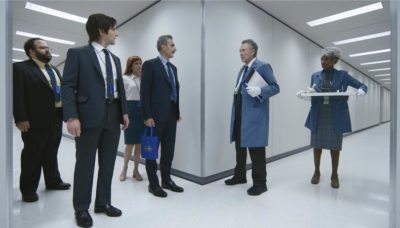The new TV show Severance drew lots of attention as it finished up its first season. Some of it even from a leftist perspective! Or at least a near left perspective. Even more interestingly, those who view Severance through a leftist lens see it as a show about worker solidarity and workplace organizing.
Can Severance teach us something about workplace organizing? I think it can! In fact, I think it highlights a major gap in the U.S. union movement. A gap that leftists could – and should – fill.
Let’s talk about all this.
Severance
I introduced Severance in a post earlier this week. But if you missed that post and haven’t seen the show, here’s the quick version. Office workers can totally separate their ‘personal self’ from their ‘work self.’ They do so via a surgical procedure that splits the brain between those two halves. And so, severed workers know nothing about their personal lives while at work and nothing about their work lives while moving about the rest of their day.
Why would a person want to do that? The show offers a few explanations for its characters. Some are working through deep grief or emotional issues. The lead character, for example, lost his wife in a car accident. A different character goes into it for strategic business reasons. She’s an executive who wants to demonstrate that the procedure is safe. As the corporate world would call it, she eats her own dog food.
Readers familiar with the white-collar world could surely give additional reasons. Many office workers struggle to keep work out of their personal lives. They find themselves spending evenings and weekends thinking about the office or even completing tasks. Severance seems to solve this problem completely.
As The Nation pointed out, the show effectively captures some of the more existential questions office workers ask. Do we do real work in this office? What if we’re not building, creating, or doing anything tangible? Is it still work? Can’t I just forget about this bullshit job?
I guess you can now.
Severance and the White-Collar World
Readers who don’t know what office culture is like miss that it involves lots of concerns like this. These jobs produce ennui and alienation of a unique sort. Many find the work uninteresting. And they just can’t get excited about it. Of course, lots of blue-collar and service workers aren’t excited about their work, either! But corporate ideology says office workers should be excited about it. And not merely as a bit of emotional labor for the customer. Rather, they should be ‘engaged,’ as the HR world tells it.
This distinctness of the white-collar world is, in fact, one of the major topics of this blog! Readers can check out the Corporate Politics 101 series for an opening guide to these issues.
Furthermore, though we’ve seen a wave of workplace organizing in the U.S. over the last few years, that wave hasn’t really hit the world of the office worker. At least most of that world. We’ve seen organizing drives in certain parts of it (e.g., the media) that have long had union drives of some sort. But it mostly passed the standard rank-and-file corporate office job.
The Uniqueness of White-Collar Organizing
The office world presents unique challenges for workplace organizing, and these challenges go beyond what we find in other sectors. It’s not much like organizing Starbucks or Amazon or teachers or nurses. It’s not even all that much like the recent New York Times strike.
Feelings of powerlessness and ennui produce the uniqueness of organizing in the white-collar world. Workers feel that middle managers, project managers, and other bosses (or quasi-bosses) pull the strings.
Comprehensive work systems like Lean and Agile exacerbate all this. They produce deskilling and work intensification, which are certainly areas of common concern with blue-collar and service sector workers. But these systems also drain the autonomy and input that office workers expect and demand.
In other sectors, like the service sector, the issues of wages and benefits stand out as a burning problem. Those issues are big enough that unions can focus on them to the exclusion of more existential issues (even if they shouldn’t). But that doesn’t work at all in the white-collar world. Many office workers make a decent salary and have decent benefits. A union pitch around salary and benefits that ignores their deeper concerns simply won’t be of interest to workers.
The Importance of White-Collar Organizing
Union organizers and leftist theorists who encounter these problems often throw in the towel on office workers. They forget about organizing them, especially the workers who earn enough income to attain ‘middle’ or ‘upper middle’ class status. And especially the ones they can dismiss as ‘PMC.’
But if the left wants to build a working-class majority, that’s just not going to cut it. Adding up all service and blue-collar workers will get you nowhere near a majority of people in the U.S. Plus, white-collar workers often inhabit areas of strategic importance, both to their company and to the economy as a whole.
And so, the left needs office workers. The left has to organize them to build the numbers and power it wants.
Severance tells us a few things about that world. It opens a window into what the workers are concerned about and the kinds of obstacles they face to seeing themselves as workers and joining the left. That’s worth thinking about.
